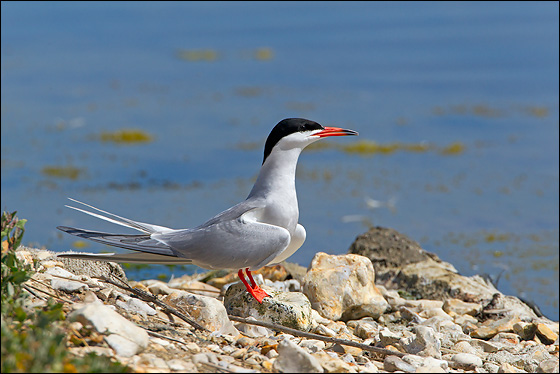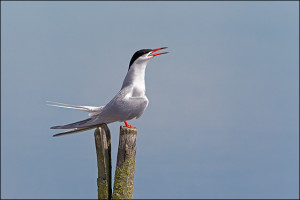Common Tern (Sterna hirundo)
The Common Tern is by far the most widespread of its family in Europe, and the most flexible in its breeding habitat. Although at heart it is a coastal bird, it has ventured further than the other Terns into inland habitats, penetrating into the heart of Europe, primarily along river systems such as the Rhine, Loire and Danube. Here it breeds in freshwater marshes, riverine shingle and on islands or artificial structures in lakes, whereas on the coast it selects beaches, islands and the upper parts of salt-marshes, which are all rather typical Tern habitats.
The Common Tern is also flexible in its feeding preferences and, unlike the Roseate Tern, for example, it can readily react to severe shortages of its favourite fish by turning to other species found in slightly different places, or to crustaceans or insects. Its main feeding method is to plunge-dive decisively after a hover, but it will also dip down to snatch items on or just above the surface.
The Common Tern is also flexible in its feeding preferences and, unlike the Roseate Tern, for example, it can readily react to severe shortages of its favourite fish by turning to other species found in slightly different places, or to crustaceans or insects. Its main feeding method is to plunge-dive decisively after a hover, but it will also dip down to snatch items on or just above the surface.
These birds nest in colonies, usually of a fair size: the average in Britain, for example, is 263 pairs. Inland colonies are smaller. Nests are rarely less than 50 cm apart and usually rather more, allowing the birds to hold a territory of 2-3m² in which ground courtship, egg-laying and feeding of the moderately itinerant young can take place. The boundaries are vigorously defended at first, but once incubation is underway things relax somewhat, although chicks wandering around may be attacked. Pairs can be extraordinarily faithful to their breeding site, and there is a record of one couple returning to exactly the same place for 17 consecutive years.
Fish play an integral role in pair-formation and maintenance. Males in early season often perform “Low Flights”, in which they fly with heavy wing-beats over the colony with fish in bill, showing it off to the females and calling loudly. Alternatively there may be “High-Flights”, in which a fish-carrying male suddenly rises up to about 200 m into the air, joined by the female, while they both glide and hold their wings in a V. Later on, once the pair has begun to establish, they enter into a “honeymoon” period, during which the male presents fish to the female about six times an hour, to keep her in condition. This time is crucial to the partnership because, by monitoring her male’s efforts, the female can decide whether or not he is suitable provider, and may leave if she deems not. It’s an important decision, because for a while before the first egg is laid, the female may be entirely dependent on her male’s offerings. The better she is fed at this time, the larger eggs she will lay, leading to higher quality young.

